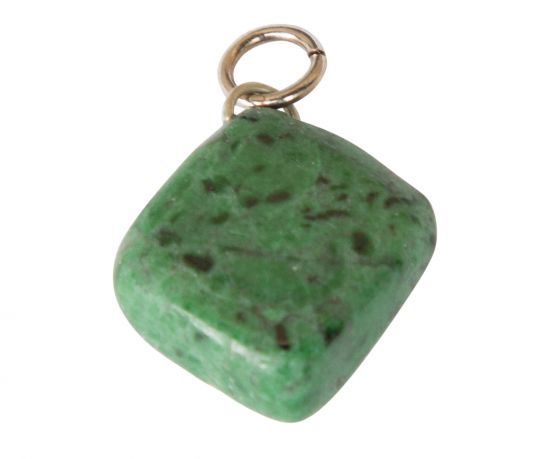We use cookies to make your experience better.
Jade with Albite or Maw sit sit "eyes" pendant from Burma
Jade is the common name for two minerals used as gemstones: jadeite and nephrite. In the economic circuit is also nepjade. This is worth less than genuine jade. One can distinguish the two from each other by real jade in a long period of time changes color as the years has been in contact with human skin. Jade has many different colors: green, brown, black or wolkenwit, from very light to very dark. Jade is like soapstone and chalcedony been cut and edited thousands of years by the Chinese. Jade was originally used as a tool but came during the Han Dynasty in vogue as jewelry. The only place where nephrite found in China located in Sinkiang around the city of Khotan. In Chinese culture is only processed jade seen as valuable. A lump of raw jade is of lesser value. In Sanzijing is listed as a comparison with education: "If one does not polishing jade, it is not costly thing if a man does not learn, his life has no meaning, because he knows the norms, values and respect for life is not. and thus will never be accomplished "(玉不琢不成器 人 不 學 不知 義). Jade is considered a valuable stone that wards off evil forces. When carried a long piece of jade on his body, for example a piece of thread around the neck, one will see that the jade slowly changes color. During the 2008 Olympics in Beijing, the medals feature jade.
Albite is a plagioclase feldspar mineral. It is the sodium endmember of the plagioclase solid solution series. As such it represents a plagioclase with less than 10% anorthite content. The pure albite endmember has the formula NaAlSi3O8. It is a tectosilicate. Its color is usually pure white, hence its name from Latin albus. It is a common constituent in felsic rocks Albite crystallizes with triclinic pinacoidal forms. Its specific gravity is about 2.62 and it has a Mohs hardness of 6 - 6.5. Albite almost always exhibits crystal twinning often as minute parallel striations on the crystal face. Albite often occurs as fine parallel segregations alternating with pink microcline in perthite as a result of exolution on cooling. There are two variants of albite, which are referred to as low albite and high albite; the latter is also known as analbite. Although both variants are triclinic, they differ in the volume of their unit cell, which is slightly larger for the high form. The high form can be produced from the low form by heating above c. 750 °C (1382 °F).[4] Upon further heating to more than c. 1050 °C the crystal symmetry changes from triclinic to monoclinic; this variant is also known as monalbite. It occurs in granitic and pegmatite masses, in some hydrothermal vein deposits and forms part of the typical greenschist metamorphic facies for rocks of originally basaltic composition. It was first reported in 1815 for an occurrence in Finnbo, Falun, Dalarna, Sweden. It is used as a gemstone












